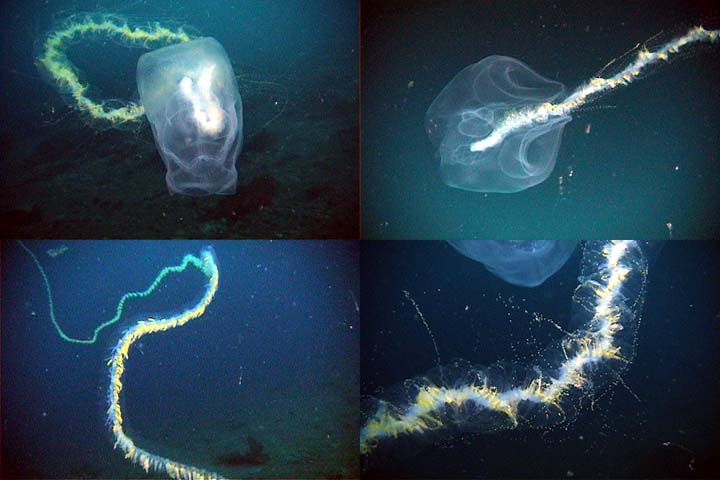



Despite the title of this week's column, I'm not referring to the Dionne Warwick hit of my college years. In this case Praya rhymes with Maya as in Angelou, but I'm not going to quote one of her poems either. I'm referring to perhaps the largest creature on the face of the earth. No, it isn't the blue whale despite what most biologists say. And it is from inner rather than outer space.
I'm referring to a genus of siphonophores that are occasionally observed right here in Catalina waters, but are more likely to be found in midwater habitats where they are the scourge of other critters. So pray tell what's a siphonophore, Dr. Bill. The one most commonly thought of is the Portuguese man-of-war whose stunning stings are often inflicted on bathers off the East Coast where it lives in the Gulf Stream. It is known primarily from tropical and subtropical waters but can be found across the globe and even in temperate to cool waters. Others found in our waters include the frayed rope (Apolemia) and hula skirt (Physophora hydrostatica) siphonophores that I've written about previously.
The Portuguese man-of-war lives near the surface where the winds and currents carry it on its somewhat unpredictable odyssey. Species of Praya are often abundant in deeper, colder waters. When we do see them, or more accurately fragments of them, near the surface it is often because they are dying.
All siphonophores are in the phylum Cnidaria which includes animals bearing stinging cells known as nematocysts like coral, jellyfish (or sea jellies if you're PC) and sea anemones. This is the phylum formerly known as Coelenterata (but no relation to the Artist formerly known as Prince or the basketball player formerly known as Artest). The first time I encountered one, I had no idea how powerful their sting was... until its tentacles became wrapped up all over my face as I filmed up close and personal. Ouch!
Praya is in a group known as the calcophoran siphonophores. They lack the gas filled floats of siphonophores like the Portuguese man-of-war because they leave in deeper water. The largest species in this genus, Praya dubia (not to be confused with "W" or dubya), may be 130 to 165 feet (40 to 50 m) long, making them larger than the blue whale (up to about 100 ft) although the whale still outweighs them by nearly 200 tons!
For a long time scientists only knew of these critters from fragments captured in plankton nets or sampled adrift in the sea. It wasn't until scientific submersibles and ROVs started bringing back images of the deeper waters that we saw these intact. I was extremely fortunate to see the extremely long individual I observed off Twin Rocks as it was fairly intact.
Starting at the forward region of the body, there is a pair of swimming bells called nectophores. These pulsing bulb-like structures pull the long "stem" of the critter along through the water column. The "stem" is a very long chain of repeated units that include components specialized for capturing food and defense (the nematocyst-bearing dactylozoids), feeding (gastrozoids) and reproduction (gonozoids). Species in this genus are distinguished by having these components, or organisms, of a bright yellow color. Since my readers always want to know about the sex life of the critters I cover, Praya reproduces by having subunits of the "stem" (known as eudoxids) break off and drift away. Not very titillating, eh? Sorry to disappoint you.
Now biologists are faced with a bit of a dilemma. Some feel Praya represents a single organism (in which case it IS the largest on the Water Planet) while others feel these individual components are organisms and Praya is a huge colony. Fortunately I'm not a siphonophore specialist and the decision is outside my realm of expertise! I'm also "off the hook" in identifying the actual species of Praya I've observed in our waters. Only the experts can distinguish the different species, and I'm just an "ex spurt."
As for the "munching" function, Praya may be the top predator in some midwater food chains. They don't look much like lions or great white sharks, but just ask the critters they feed on about that. These siphonophores are bioluminescent, giving off a soft blue light that is believed to attract prey. They capture small sea jellies, crustaceans and even young fish with their sting cells. Based on the strength of their sting, I wonder if any creature is capable of munching on them!
The first Praya I encountered was in pretty deep water (150 ft) off Twin Rocks. Any time I find a new critter to film, I focus entirely on it... and not on my SCUBA gauges as I should. I did stay down a bit too long with this one, and had a fair decompression obligation to meet before I could safely surface. Unfortunately my dive computer battery failed as I began my required stop. I knew how long I needed to stay under, but without a computer or watch, I had to count the seconds and minutes as best I could. 1,001... 1,002... 1,003.... 100,800... now I can surface! Whew! I did say a little prayer on that dive. Ever since then I've carried a second computer on my wrist as backup.
© 2011 Dr. Bill Bushing. Watch the "Dive Dry with Dr. Bill" underwater videos on Catalina Cable TV channel 29, 10:00 AM weekdays and on Charter Communications Cable channel 33 at 7:30 PM on Tuesdays in the Riverside/Norco area. Please help me climb out of self-imposed poverty... buy my DVD's (see this link). Yes, take Dr. Bill home with you... we'll both be glad you did!
To return to the list of ALL of Dr. Bill's "Dive Dry" newspaper columns, click here.

The swimming bell of Praya
(top) and the (ouch) stinging tentacles it drags behind it.
This document maintained by
Dr. Bill Bushing.
Material
and images © 2011 Star Thrower Educational Multimedia